Where you see this button
Spider Collector's Journal (20th page: 2010) Copyright © 2010 by Rod Crawford
Here's the 20h page of narratives of fun (and not so fun)
trips to collect spiders for research at the Burke
Museum, often accompanied by capable field volunteer Laurel Ramseyer. Most also appeared in Scarabogram, newsletter of "Scarabs:
The Bug Society." Dates of field trips head each paragraph. Maps showing
the location of sites within Washington state follow the grid system outlined
in the Washington
Spider Checklist. RETURN
TO INDEX
Where you see this button ![]() in a
field trip account, click it to get a page of collecting site photos!
in a
field trip account, click it to get a page of collecting site photos!
 |
![]() 20 II 2010: Photographer Lynette Schimming, an editor at BugGuide.net and a Scarab since the 2007 Rattlesnake Mountain hike, has been helping Morse Wildlife Preserve (in central Pierce County) document their fauna. The preserve was situated in an undersampled area, and we decided an actual spider collecting trip would greatly enhance the project. As usual there was a stretch of delightful weather in late February, so the trip came off well. Arriving at the site only a bit late, we met land steward Mary Sue Gee, who joined us as we walked to the back of the former farm and sifted willow litter at the edge of a large, natural marsh. The litter was so cold that little was moving, but there were 2 identifiable species including our undescribed Oedothorax. Right next to us was a large isolated Douglas-fir with low foliage all around; beating about half the low branches got me 11 species including a linyphiid I don't immediately recognize. Mary Sue had to leave before we swept the grass (at that point a former farm field, but still with good native spiders including one of the prairie-specialist Metepeiras, still juvenile at this season). The barn added 3 species, best one being the "ranger station funnel weaver" Novalena intermedia, from under a boat. Finally we beat a large snowberry thicket, but I clumsily lost most of those specimens (probably nothing special).
20 II 2010: Photographer Lynette Schimming, an editor at BugGuide.net and a Scarab since the 2007 Rattlesnake Mountain hike, has been helping Morse Wildlife Preserve (in central Pierce County) document their fauna. The preserve was situated in an undersampled area, and we decided an actual spider collecting trip would greatly enhance the project. As usual there was a stretch of delightful weather in late February, so the trip came off well. Arriving at the site only a bit late, we met land steward Mary Sue Gee, who joined us as we walked to the back of the former farm and sifted willow litter at the edge of a large, natural marsh. The litter was so cold that little was moving, but there were 2 identifiable species including our undescribed Oedothorax. Right next to us was a large isolated Douglas-fir with low foliage all around; beating about half the low branches got me 11 species including a linyphiid I don't immediately recognize. Mary Sue had to leave before we swept the grass (at that point a former farm field, but still with good native spiders including one of the prairie-specialist Metepeiras, still juvenile at this season). The barn added 3 species, best one being the "ranger station funnel weaver" Novalena intermedia, from under a boat. Finally we beat a large snowberry thicket, but I clumsily lost most of those specimens (probably nothing special).
Moving on to a second site Mary Sue showed us, I swept the edge of the marsh getting (among others) the good wetland species Tetragnatha caudata and Clubiona norvegica. The maple litter (probably richer last fall) produced 8 species, several of them photogenic. Tree moss was a bit sparse in this grove, but I gathered a small bagful. Every time I shook some over the sifting cloth, so many spiders fell out that Lynette kept saying "Holy moly!" Alas, the majority were an unidentifiable juvenile black linyphiid, and there were none of the moss-specialist spiders I expected. We wanted to try litter from the nearby Oregon ash trees but there was almost none on the ground – I guess it all fell in the marsh. At this point, the warmth needed for sifting went away with the lowering sun, so we returned to the parking area and entered the roadside conifer forest for understory beating. This added a few more species before it became too dark to see them. A 30-species sample in February isn't bad at all, and this site fully justifies its preserve status.
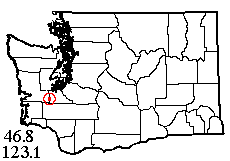 |
![]() 16 IV 2010: The first official spring trip with my regular field partner Laurel Ramseyer visited an area NW of the town of Rochester (near an unincorporated "wide spot" named Gate), where I hoped to find further remnants of the rare gravelly prairie habitat. The partly-cloudy weather was pleasantly warm and dry. After trying a site that Thurston County's online GIS said was a public right-of-way, and finding it nonetheless posted no trespassing, we settled on a county-owned triangle between 3 railroad lines, one still in use. This site certainly was prairie once, but it's now so heavily overrun with invasive plants that it hardly deserves the name. There are Garry oaks there though, reproducing amid the Scots broom! In spite of the degraded habitat, there were spiders to be found: grass, oak litter, moss, snowberry, a solitary apple tree, and ground-surface moss produced 14 species. Laurel sat down on a stump that broke apart under her, revealing the site's best spider, rare Callobius deces. In adjacent Douglas-fir forest I got several additional species from fir foliage, tree moss and understory.
16 IV 2010: The first official spring trip with my regular field partner Laurel Ramseyer visited an area NW of the town of Rochester (near an unincorporated "wide spot" named Gate), where I hoped to find further remnants of the rare gravelly prairie habitat. The partly-cloudy weather was pleasantly warm and dry. After trying a site that Thurston County's online GIS said was a public right-of-way, and finding it nonetheless posted no trespassing, we settled on a county-owned triangle between 3 railroad lines, one still in use. This site certainly was prairie once, but it's now so heavily overrun with invasive plants that it hardly deserves the name. There are Garry oaks there though, reproducing amid the Scots broom! In spite of the degraded habitat, there were spiders to be found: grass, oak litter, moss, snowberry, a solitary apple tree, and ground-surface moss produced 14 species. Laurel sat down on a stump that broke apart under her, revealing the site's best spider, rare Callobius deces. In adjacent Douglas-fir forest I got several additional species from fir foliage, tree moss and understory.
Still hoping to find some real prairie, we independently invaded the grounds of what we assumed was a public fish hatchery just to the east. Here, we hit "pay dirt" with one large and a few small tracts of fine-looking prairie still free from the encroaching invasive broom and blackberry. Sweep samples here produced 16 species, several of them different from what we found on the degraded county tract. Pardosa vancouveri were active, and there were several really large oak trees. I returned from my explorations to find Laurel refreshed by a nap, and we both visited some of the uninhabited hatchery buildings for 6 more species on various manmade structures. Between 6 different subsites, we ended the day with 37 species.
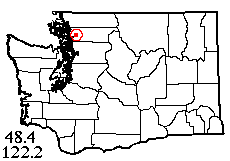 |
![]() 7 V 2010: Some correspondence with the Skagit Land Trust about their acquisition of bog property south of Big Lake, led to an arrangement to collect spiders on some of their other properties. After many delays, today was the day! Laurel and I started with Big Rock, a 500-foot-tall lump of Jurassic greenstone jutting up out of the flat Skagit River delta. Reportedly there was an easy new trail from a wretched new housing development just to the west. Easy yes, but it goes nowhere near Big Rock. So we tried the "not easy" trail from Highway 9 on the east side, and found it no problem at all, even for people still emerging from winter couch-potato mode. Big Rock is bald-peaked and the trail is more primitive above the forest. In the summit area, we beat spiders from shrubs and small trees, sifted moss, checked out logs, bark and aerial webs, and admired the 360° view. Back below "treeline" I sifted some very nice maple litter while Laurel beat the understory. Overall, we came away from Big Rock with 30 identifiable species for our morning's work. The best record was a little amaurobiid, Zanomys aquilonia, that prefers savanna-type habitats.
7 V 2010: Some correspondence with the Skagit Land Trust about their acquisition of bog property south of Big Lake, led to an arrangement to collect spiders on some of their other properties. After many delays, today was the day! Laurel and I started with Big Rock, a 500-foot-tall lump of Jurassic greenstone jutting up out of the flat Skagit River delta. Reportedly there was an easy new trail from a wretched new housing development just to the west. Easy yes, but it goes nowhere near Big Rock. So we tried the "not easy" trail from Highway 9 on the east side, and found it no problem at all, even for people still emerging from winter couch-potato mode. Big Rock is bald-peaked and the trail is more primitive above the forest. In the summit area, we beat spiders from shrubs and small trees, sifted moss, checked out logs, bark and aerial webs, and admired the 360° view. Back below "treeline" I sifted some very nice maple litter while Laurel beat the understory. Overall, we came away from Big Rock with 30 identifiable species for our morning's work. The best record was a little amaurobiid, Zanomys aquilonia, that prefers savanna-type habitats.
![]() Mud Lake preserve, confusingly located in the town of Clear Lake, faces its town side with a dense blackberry thicket. Much of the preserve is beautiful, natural marsh, but the blackberry is invading, and something needs doing before all the wet meadow habitat is destroyed. Sweeping the marsh and meadow produced fewer specimens than expected but they were very diverse, 15 species including several wetland specialists. Extremely rare Tetragnatha dearmata was here, plus only the second Dictyna annulipes from western Washington, and an attractive reddish linyphiid that I can't yet place even to genus (resembles a Dismodicus except for the carapace). Additional species came from under wood chips and foliage of small spruce trees, and Larinioides patagiatus had its orb web on the interpretive sign. A great preserve, well worth the effort to preserve from invasive plants.
Mud Lake preserve, confusingly located in the town of Clear Lake, faces its town side with a dense blackberry thicket. Much of the preserve is beautiful, natural marsh, but the blackberry is invading, and something needs doing before all the wet meadow habitat is destroyed. Sweeping the marsh and meadow produced fewer specimens than expected but they were very diverse, 15 species including several wetland specialists. Extremely rare Tetragnatha dearmata was here, plus only the second Dictyna annulipes from western Washington, and an attractive reddish linyphiid that I can't yet place even to genus (resembles a Dismodicus except for the carapace). Additional species came from under wood chips and foliage of small spruce trees, and Larinioides patagiatus had its orb web on the interpretive sign. A great preserve, well worth the effort to preserve from invasive plants.
Our one problem at Mud Lake was that the tall meadow was so dense, all the wolf spiders escaped us with ease. We hoped to remedy that lack at a small Department of Wildlife tract on Beaver Lake to the southwest. Sure enough, I added two Pardosa species to the bag, and sweeping under the willows got me a juvenile fishing spider, Dolomedes triton, showing that this lake is also high quality wetland; meanwhile, Laurel got 6 species from the outhouse and signs (the night closure sign had a curiously literary turn of phrase). Our last stop, for moss fauna, was in forest along an old railroad grade (turned powerline route) on state land north of Clear Lake. The one really mossy tree I could find added 6 moss species, and Nesticus silvestrii turned up in the litter. As the sun set west of I-5, we could look back on a very profitable 59-species day.
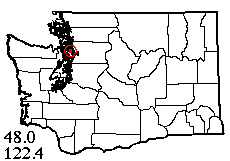 |
![]() 12 V 2010: Back in January, I helped retired nature-lover Jean Knapp identify a moth she'd photographed on her rural land near Langley, Whidbey Island. It turned out to be the rare Hyalophora euryalis. Naturally, I wangled an invitation to collect on Jean's property in the spring. Jean has 10 acres, much of it an enormous lawn (used at times for local events) but including natural forest and willow swamp; her nephew across the road has more, with tall grass field and a more varied forest. Laurel and I arrived late on a partly-cloudy morning, greeted by Jean and her dogs (one friendly, one always barking), and Laurel immediately discovered a stand of Pinus monticola with many cones for her favorite collecting technique! While she tapped 15 varied, but not especially rare species from the cones, I got the same number from Douglas-fir foliage. I found good log habitat in the woods while Laurel swept the big field. Salal foliage, moss on logs in the swamp, and toolsheds gave several more species each. Though unable to find any good leaf litter, we had recorded 44 species from Jean's land by early afternoon. One interesting specimen, an adult male of the invasive Philodromus dispar (see album) had somehow lost both palps before his last molt. The regenerated organs had no trace of adult genitalia: a gelding, so to speak.
12 V 2010: Back in January, I helped retired nature-lover Jean Knapp identify a moth she'd photographed on her rural land near Langley, Whidbey Island. It turned out to be the rare Hyalophora euryalis. Naturally, I wangled an invitation to collect on Jean's property in the spring. Jean has 10 acres, much of it an enormous lawn (used at times for local events) but including natural forest and willow swamp; her nephew across the road has more, with tall grass field and a more varied forest. Laurel and I arrived late on a partly-cloudy morning, greeted by Jean and her dogs (one friendly, one always barking), and Laurel immediately discovered a stand of Pinus monticola with many cones for her favorite collecting technique! While she tapped 15 varied, but not especially rare species from the cones, I got the same number from Douglas-fir foliage. I found good log habitat in the woods while Laurel swept the big field. Salal foliage, moss on logs in the swamp, and toolsheds gave several more species each. Though unable to find any good leaf litter, we had recorded 44 species from Jean's land by early afternoon. One interesting specimen, an adult male of the invasive Philodromus dispar (see album) had somehow lost both palps before his last molt. The regenerated organs had no trace of adult genitalia: a gelding, so to speak.
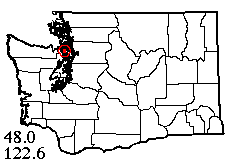 |
![]() On our
December 2007 visit to Marrowstone Island, we spent a few minutes collecting east of the 122.7 longitude line before I discovered my mistake, in a habitat so rich that 12 species records resulted. In planning today's trip, I discovered that Bush Point on Whidbey Island projects into the other side of the same 1/10 degree gridspace. Surely it would be easy to get 9 or 10 more species there on a nice spring day… Well, Bush Point was largely transformed into a housing tract some years back. You can't call a housing tract something simple like Bush Point: to residents, it's Lighthouse Shores. The lighthouse itself, plus part of a central pond and marsh, are still public land. Arriving in weather become gloomy and breezy, I found access to the marsh from the intended parking place blocked by a dense blackberry thicket. I got a few species from the roadside verge and ditch foliage, including the uncommon Theridion agrifoliae. Around the corner, a forlorn stand of native salmonberry added a species. Laurel still had her rubber boots from last week, so she was elected to bravely penetrate a thin spot in the blackberry and nettle and actually collect in the marsh (including some relatively natural habitat). We hoped to add beach species at the lighthouse. It may be public according to the county assessor, but the Lighthouse Shores Homeowners don't believe it, and have it all posted. There were no visible spiders on the building anyway; fortunately, a nice lady let us collect from native shore pines in her yard. All this left me uncertain whether I had enough species or not, but at the last minute, tall grass and yellow flowers in a vacant lot with no keep-out signs gave me 3 more species, bringing the area up to 26 records.
On our
December 2007 visit to Marrowstone Island, we spent a few minutes collecting east of the 122.7 longitude line before I discovered my mistake, in a habitat so rich that 12 species records resulted. In planning today's trip, I discovered that Bush Point on Whidbey Island projects into the other side of the same 1/10 degree gridspace. Surely it would be easy to get 9 or 10 more species there on a nice spring day… Well, Bush Point was largely transformed into a housing tract some years back. You can't call a housing tract something simple like Bush Point: to residents, it's Lighthouse Shores. The lighthouse itself, plus part of a central pond and marsh, are still public land. Arriving in weather become gloomy and breezy, I found access to the marsh from the intended parking place blocked by a dense blackberry thicket. I got a few species from the roadside verge and ditch foliage, including the uncommon Theridion agrifoliae. Around the corner, a forlorn stand of native salmonberry added a species. Laurel still had her rubber boots from last week, so she was elected to bravely penetrate a thin spot in the blackberry and nettle and actually collect in the marsh (including some relatively natural habitat). We hoped to add beach species at the lighthouse. It may be public according to the county assessor, but the Lighthouse Shores Homeowners don't believe it, and have it all posted. There were no visible spiders on the building anyway; fortunately, a nice lady let us collect from native shore pines in her yard. All this left me uncertain whether I had enough species or not, but at the last minute, tall grass and yellow flowers in a vacant lot with no keep-out signs gave me 3 more species, bringing the area up to 26 records.
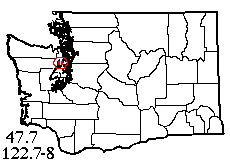 |
![]() 16 V 2010: I'd often collected on the Kitsap and Olympic peninsulas but never on the smaller Toandos Peninsula in between, so I made a collecting plan for two state land parcels there with good habitat potential. On the day when Anh-Tuyet Nguyen, entomology student of Evan Sugden, wanted to document a collecting trip for class, that was the only area with no chance of rain – so off we went! First stop was Silent Lake, not so silent since the southern, private part turned residential. At the north public end is a wetland that looked as if it might be a Sphagnum bog. Well, if there's any Sphagnum there we couldn't reach it, but we collected in a nice mixed riparian forest along a shady linear marsh. Sifting leaf litter gave us 9 spider and 5 harvestman species. The abundant moss produced 10 more, while Anh-Tuyet and her somewhat arachnophobic friend helped collect moss and litter and beat the understory. With shrubs, plus roadside verge grass and fir foliage, we had 32 species here by early afternoon.
16 V 2010: I'd often collected on the Kitsap and Olympic peninsulas but never on the smaller Toandos Peninsula in between, so I made a collecting plan for two state land parcels there with good habitat potential. On the day when Anh-Tuyet Nguyen, entomology student of Evan Sugden, wanted to document a collecting trip for class, that was the only area with no chance of rain – so off we went! First stop was Silent Lake, not so silent since the southern, private part turned residential. At the north public end is a wetland that looked as if it might be a Sphagnum bog. Well, if there's any Sphagnum there we couldn't reach it, but we collected in a nice mixed riparian forest along a shady linear marsh. Sifting leaf litter gave us 9 spider and 5 harvestman species. The abundant moss produced 10 more, while Anh-Tuyet and her somewhat arachnophobic friend helped collect moss and litter and beat the understory. With shrubs, plus roadside verge grass and fir foliage, we had 32 species here by early afternoon.
Then south toward the tip of the peninsula, past Blueberry Hill Drive (no doubt somebody found his thrill there), and west toward Tabook Point where two DNR clearcuts of different ages provide varied habitats. I'd hoped to make my way from the clearcut edge to a beach bluff a quarter mile west, but the underbrush was far too dense. However, young Douglas-fir crowding up to the gated logging road yielded a mind-boggling 17 species to the beating net – including a Spirembolus species that may be new. Anh-Tuyet, a complete tyro at arachnology, proved the value of young eyes by spotting Phalangium opilio, Tarentula kochii, Pardosa vancouveri, Callilepis pluto, and Habronattus ophrys active on the roadside. Rare H. ophrys largely occurs in high quality vegetated beach and sandspit habitats, but this is the second time it's been found along a dirt logging road just inland from the beach, which must provide a sufficiently beachlike micro-environment. On the same amazing roadside, my aging eyes found Zelotes fratris and Habronattus oregonensis (the "Popeye spider" with its bulging first tibiae), a bit less exciting but still worthy records. Near where I'd left my pack, some alders sticking above the young firs indicated a possible riparian zone below the downhill road bank. Scrambling down, I found myself in a perfectly lovely, gravel-floored little gully, where clearly the loggers must have done what they're supposed to and left a riparian buffer. I extracted 12 more species from the riparian litter and understory. Finally, just down the road in the newer clearcut, we searched for "clearcut heath" spiders. Cutleaf blackberry made this harder than it should have been, but I did add a few more species, for a total of 37 from this second area, including several decided rarities. A productive day in good company, and the ferry ride home added one more to my "sunset collection."
 |
![]() 21 V 2010: Another year, another BioBlitz. I'd previously collected spiders for the White River and Roy bioblitzes, in each case exploring areas new to me, which is what spider distribution study is all about. This year's event though, was at the Washington Park Arboretum (easy walking distance from my home campus) where I had prior records extending over decades. Oh well, I thought, might as well stroll down and see what I can find for them. Weather was unsuitable for a real field trip anyway, very threatening and in fact raining every other place but the arboretum – or so it seemed! I arrived not long after the official start, with not many other people involved yet (likely due to the discouraging weather). Instructed to concentrate on Foster Island, a relatively ungroomed area bordering on a natural marsh, I headed straight there and started sweeping riparian grass at the south end. This produced several species, most interesting being the undescribed Lepthyphantes #8 and Dictyna annulipes (found in western Washington only twice before). A patch of buttercups added some crab spiders including the expected Misumena vatia. Cottonwood litter gave me a few expected species plus the very uncommon (though non-native) Achaearanea acoreensis. Some BioBlitz volunteers pointed me to an area of good conifer foliage at the other end of the south lawn, which gave me lots and lots of the introduced Theridion tinctum, but also the native Philodromus spectabilis – and more D. annulipes. Nearby was a stand of non-native oaks with good litter, noted for later.
21 V 2010: Another year, another BioBlitz. I'd previously collected spiders for the White River and Roy bioblitzes, in each case exploring areas new to me, which is what spider distribution study is all about. This year's event though, was at the Washington Park Arboretum (easy walking distance from my home campus) where I had prior records extending over decades. Oh well, I thought, might as well stroll down and see what I can find for them. Weather was unsuitable for a real field trip anyway, very threatening and in fact raining every other place but the arboretum – or so it seemed! I arrived not long after the official start, with not many other people involved yet (likely due to the discouraging weather). Instructed to concentrate on Foster Island, a relatively ungroomed area bordering on a natural marsh, I headed straight there and started sweeping riparian grass at the south end. This produced several species, most interesting being the undescribed Lepthyphantes #8 and Dictyna annulipes (found in western Washington only twice before). A patch of buttercups added some crab spiders including the expected Misumena vatia. Cottonwood litter gave me a few expected species plus the very uncommon (though non-native) Achaearanea acoreensis. Some BioBlitz volunteers pointed me to an area of good conifer foliage at the other end of the south lawn, which gave me lots and lots of the introduced Theridion tinctum, but also the native Philodromus spectabilis – and more D. annulipes. Nearby was a stand of non-native oaks with good litter, noted for later.
North of the floating-bridge approach that bisects the island, there's another lawn with hawthorn trees that added a few species, plus more D. annulipes. I thought I'd try the woodland understory here, but it was almost entirely invasive ivy! The best part of Foster Island is the natural marsh accessed by the Waterside Trail and boardwalk. Lake level being unusually high, the trail was soggy and the boardwalk underwater! But sweeping the marsh and beating the willow showed an excellent population of wetland specialist Tetragnatha caudata, plus Dismodicus, Erigone, Entelecara, yet more D. annulipes, and an unfamiliar crab spider in the Philodromus imbecillus group. It's either new, or a sagebrush-country species that ballooned all the way over the Cascades; only later dissection will tell. Willow litter, which might have added good species, was all underwater. Meanwhile, the Husky Band had been serenading me from the stadium right across Union Bay. With daylight fading, I grabbed a big bag of oak litter and brought it back to the lighted greenhouse to sift, adding several more species, including adults of introduced Clubiona pallidula that I'd got juveniles of earlier. Total for a few hours and no assistant, 38 species (not all mature enough to identify), very worthwhile.
![]() 26 VI 2010: Last fall's trip to Tolt-MacDonald Park revealed this diverse, 574-acre park to be an excellent site for a group outing. Accordingly, this year's Scarabs field meeting was scheduled there. June was such a wet month that we feared the worst, but fortunately Saturday the 26th was partly-cloudy and pleasant. Not a few Scarabs forgot we were meeting in the field this month, but 9 Scarabs and Parascarabs showed up, supplemented by our old friend Markku Savela from Finland, accompanied by wife and child. The meadow habitat, much lusher in June, led us to that oxbow pond whose existence I'd only suspected last fall. Assorted interesting insects and spiders fell into the group's nets. I got about 6 spider species not taken last fall, including the uncommon Tetragnatha elongata swept from emergent grass in the pond. Later, the group hiked up into the forested uplands, but found no very unusual specimens there. The pond area was clear winner for group activity. Click the album icon to see some June photos added to those taken in the fall.
26 VI 2010: Last fall's trip to Tolt-MacDonald Park revealed this diverse, 574-acre park to be an excellent site for a group outing. Accordingly, this year's Scarabs field meeting was scheduled there. June was such a wet month that we feared the worst, but fortunately Saturday the 26th was partly-cloudy and pleasant. Not a few Scarabs forgot we were meeting in the field this month, but 9 Scarabs and Parascarabs showed up, supplemented by our old friend Markku Savela from Finland, accompanied by wife and child. The meadow habitat, much lusher in June, led us to that oxbow pond whose existence I'd only suspected last fall. Assorted interesting insects and spiders fell into the group's nets. I got about 6 spider species not taken last fall, including the uncommon Tetragnatha elongata swept from emergent grass in the pond. Later, the group hiked up into the forested uplands, but found no very unusual specimens there. The pond area was clear winner for group activity. Click the album icon to see some June photos added to those taken in the fall.
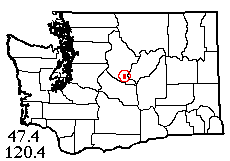 |
![]() 2 VII 2010: Finally it was July, and the weather almost began to seem like summer. And Laurel was available for a full-fledged trip. Forecasts were still not entirely dry for western Washington, so we headed east of the Cascades and ascended Number Two Canyon from the "back side" of Wenatchee toward Horse Lake Mountain, high enough to rise out of the well-cooked lowland fauna. We had to do some of the rising on foot when the road deteriorated under Laurel's town car. Our site was a mountain meadow with very open Ponderosa pine forest around. A fire perhaps 20 years before had encouraged the pine seeds to germinate, so pines of all ages were abundant. Flowers were still around too, and the clouds and breezes kept things comfortably cool – all in all, a delightful place. I started out sweeping the open meadow, getting no spiders but lots of black true bugs, so I tried under the pines and eventually swept 9 species, including Philodromus and Dictyna that I don't immediately recognize. Pine and fir foliage added several more species. I got a monster Callobius nevadensis and a very cool Alaus click beetle under stump bark, and had good hopes for scraping pine-trunk bark scales, but alas, it produced nothing.
2 VII 2010: Finally it was July, and the weather almost began to seem like summer. And Laurel was available for a full-fledged trip. Forecasts were still not entirely dry for western Washington, so we headed east of the Cascades and ascended Number Two Canyon from the "back side" of Wenatchee toward Horse Lake Mountain, high enough to rise out of the well-cooked lowland fauna. We had to do some of the rising on foot when the road deteriorated under Laurel's town car. Our site was a mountain meadow with very open Ponderosa pine forest around. A fire perhaps 20 years before had encouraged the pine seeds to germinate, so pines of all ages were abundant. Flowers were still around too, and the clouds and breezes kept things comfortably cool – all in all, a delightful place. I started out sweeping the open meadow, getting no spiders but lots of black true bugs, so I tried under the pines and eventually swept 9 species, including Philodromus and Dictyna that I don't immediately recognize. Pine and fir foliage added several more species. I got a monster Callobius nevadensis and a very cool Alaus click beetle under stump bark, and had good hopes for scraping pine-trunk bark scales, but alas, it produced nothing.
Laurel had "warmed up" for her favorite technique of tapping spiders out of fallen pine cones at a rest stop on the way (in the process, getting her, and our, third record of the pine-cone spider Theridion rabuni). On Horse Lake Mountain she went "hog wild" on the cones, tapping 200 of them in all! But aside from juveniles, only 2 spider, 1 harvestman and 1 pseudoscorpion species resulted, a clear case of diminishing returns. She had better luck turning over a few rocks, finding the third known specimen of an undescribed Neon (tiny jumping spider) and a few others. Late in the day, we proceeded up the road to a ravine I'd spotted on the map, in hopes of leaf litter. Sure enough, there were aspens, willows, and unusual species of alder and maple all contributing to deep litter in the hollows, adding 4 species to the bag; 2 more came off the riparian bushes. In all we collected 26 species, not that many but including very good records, to add to 3 old records from 1982. Tired but happy, we celebrated by eating masterpieces from EZ's Burger Deluxe in Wenatchee.
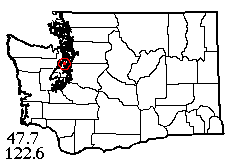 |
![]() 8 VII 2010: My friend Della signed up for a class in the Kitsap County town of Silverdale, where she'd never been. She enticed me to come along and help navigate by combining this with a collecting trip. Not her fault that the day turned out to be a 93° scorcher. Of 2 pre-selected Kitsap County Parks properties, the first one we checked, off Rude Road near Poulsbo, was accessible and allowed me to supplement a 3-species catch made back in 1987. In the album, you'll note a nice stand of timber in the SW corner of the 2009 aerial photo. It was cut this year. That explains the existence of a band of grassy field along one edge of the giant clearcut – it was a gas-line clearing, shaded by forest that's not there any more. Sweeping the grass got me 5 species. Even some ubiquitous introduced grassland spiders weren't there, but the grass produced the 2 best species at the site, Philodromus oneida and Ceraticelus vesperus. A lush-looking salal stand, also newly exposed to the sun by timber harvest, produced no spiders at all, but the fauna of nearby salal still in the shade was very diverse, 13 species from the foliage and 2 more from the litter. For all that I was at the edge of a Douglas-fir forest, fir foliage proved very hard to reach: too high on older trees while the young trees were enmeshed in a jungle of (mainly invasive) shrubs and vines. But I did get 5 species from this habitat, for about 21 total by the time Della returned from Silverdale.
8 VII 2010: My friend Della signed up for a class in the Kitsap County town of Silverdale, where she'd never been. She enticed me to come along and help navigate by combining this with a collecting trip. Not her fault that the day turned out to be a 93° scorcher. Of 2 pre-selected Kitsap County Parks properties, the first one we checked, off Rude Road near Poulsbo, was accessible and allowed me to supplement a 3-species catch made back in 1987. In the album, you'll note a nice stand of timber in the SW corner of the 2009 aerial photo. It was cut this year. That explains the existence of a band of grassy field along one edge of the giant clearcut – it was a gas-line clearing, shaded by forest that's not there any more. Sweeping the grass got me 5 species. Even some ubiquitous introduced grassland spiders weren't there, but the grass produced the 2 best species at the site, Philodromus oneida and Ceraticelus vesperus. A lush-looking salal stand, also newly exposed to the sun by timber harvest, produced no spiders at all, but the fauna of nearby salal still in the shade was very diverse, 13 species from the foliage and 2 more from the litter. For all that I was at the edge of a Douglas-fir forest, fir foliage proved very hard to reach: too high on older trees while the young trees were enmeshed in a jungle of (mainly invasive) shrubs and vines. But I did get 5 species from this habitat, for about 21 total by the time Della returned from Silverdale.
So it's 4:30 pm, the ZipCar not due back until 11:30. What to do next? I thought of trying my other planned site, west of Silverdale on Hood Canal. But we soon found these roads jammed with rush-hour traffic heading home to Seabeck. Not quite sure I'd got enough species from the Poulsbo area, I decided to look for a site that might give me some riparian fauna. A little driving around brought us to a nice wide county-road right-of-way crossing Dogfish Creek in a rural valley. Once past the screening blackberries, this salmon stream looked pretty nice, but the foliage had no spiders I hadn't gotten at Rude Road. However, I got 3 additional species from roadside grass and fir foliage, including yet another range extension for Entelecara congenera, a recently introduced microspider. Now I have 27-29 species from the Poulsbo area, so it was worth doing.
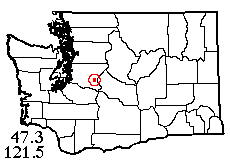 |
![]() 15 VII 2010: I had 10 species records from someone's 1972-5 research project at Findley Lake in the Cedar River Watershed, and had long planned to supplement this old sample. Visiting Markku Savela wanted a short trip to break in a new rental car, so we (Markku, Valentina, 2-year-old Tristan, and I) headed up the Hansen Creek Road (just outside the watershed) expecting to park where the John Wayne (Iron Horse) Trail crosses the road and access habitats along the trail. But I goofed - after half an hour's vain search for the trail, we spotted it about 100 feet above our heads, where it crosses on an inaccessible trestle. In a hastily conceived Plan B, I navigated us up a logging road that goes nearly to the crest of the divide. Unfortunately, only a vast clearcut was accessible at the top. The July sun had blazed most spiders out of existence at the 4280-foot level, but I managed to get 4 species. Markku didn't have much luck either but he got some stunning photos of a tiger beetle. We decided to work our way back downhill, and the next stop (at the bottom of the same giant clearcut) was luckier for me. Some natural forest had been left along a tiny stream, and in the moist shade I got 8 species including an interesting Poeciloneta. But Markku still found no butterflies to photograph.
15 VII 2010: I had 10 species records from someone's 1972-5 research project at Findley Lake in the Cedar River Watershed, and had long planned to supplement this old sample. Visiting Markku Savela wanted a short trip to break in a new rental car, so we (Markku, Valentina, 2-year-old Tristan, and I) headed up the Hansen Creek Road (just outside the watershed) expecting to park where the John Wayne (Iron Horse) Trail crosses the road and access habitats along the trail. But I goofed - after half an hour's vain search for the trail, we spotted it about 100 feet above our heads, where it crosses on an inaccessible trestle. In a hastily conceived Plan B, I navigated us up a logging road that goes nearly to the crest of the divide. Unfortunately, only a vast clearcut was accessible at the top. The July sun had blazed most spiders out of existence at the 4280-foot level, but I managed to get 4 species. Markku didn't have much luck either but he got some stunning photos of a tiger beetle. We decided to work our way back downhill, and the next stop (at the bottom of the same giant clearcut) was luckier for me. Some natural forest had been left along a tiny stream, and in the moist shade I got 8 species including an interesting Poeciloneta. But Markku still found no butterflies to photograph.
Down at the base of the mountain was a powerline clearing, normally a great habitat though now too late in the year for low elevation spiders. Spiders were sparse, but the field layer plus adjacent understory foliage gave me another 8 species. A last stop on the main river valley road marked my total failure to find a route to the bank of the South Fork Snoqualmie River, but I found the day's only mature wolf spider under stump bark. My 19 spider species, though hardly an outstanding catch, brought the old sample up to 27 species, so the day was worthwhile for me, and the new car definitely proved its mettle on the rough subalpine logging road.
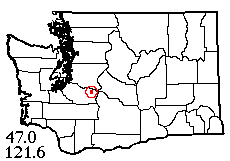 |
![]() 23 VII 2010: The time had come for high-elevation collecting. Markku, partly recovered from the Savela family's summer cold, was ready to breathe mountain air on a not too arduous trip. I'd already identified some high country accessible by road just north of Mt. Rainier National Park, and we got there in about 2 hours easy driving. First stop was Lonesome Lake (4800 feet elevation), at the long forest road's very end. A really beautiful spot but not lacking in small, stealthy mosquitos; fortunately we had repellant (scratch, scratch). My initial catch of 9 spider species from conifer foliage was promising, and included one of the red-patterned undescribed mountain Pityohyphantes. I swept only 6 species from the narrow lake-shore meadow, and local wolf spider populations had already crashed; I collected only one and Markku photographed a different one. The litter and dead wood on the floor of these high forests can be very productive, and here got me 12 species including an unfamiliar hahniid. Markku found Xysticus locuples on the outside of the outhouse while I found several Steatoda hespera inside. After sweeping roadside shrubs for little that was new, we decided to try some different environments along our route out of the area.
23 VII 2010: The time had come for high-elevation collecting. Markku, partly recovered from the Savela family's summer cold, was ready to breathe mountain air on a not too arduous trip. I'd already identified some high country accessible by road just north of Mt. Rainier National Park, and we got there in about 2 hours easy driving. First stop was Lonesome Lake (4800 feet elevation), at the long forest road's very end. A really beautiful spot but not lacking in small, stealthy mosquitos; fortunately we had repellant (scratch, scratch). My initial catch of 9 spider species from conifer foliage was promising, and included one of the red-patterned undescribed mountain Pityohyphantes. I swept only 6 species from the narrow lake-shore meadow, and local wolf spider populations had already crashed; I collected only one and Markku photographed a different one. The litter and dead wood on the floor of these high forests can be very productive, and here got me 12 species including an unfamiliar hahniid. Markku found Xysticus locuples on the outside of the outhouse while I found several Steatoda hespera inside. After sweeping roadside shrubs for little that was new, we decided to try some different environments along our route out of the area.
The trail to Mule Lake eluded us, but the stream it feeds (Mule Creek) looked beautiful. Sifting lush moss along the banks got me precisely zero mature spiders, however. One unusual-looking Theridion swept at this site was juvenile – oh, well. Our last stop was in a subalpine flower meadow on the crest of Huckleberry Ridge. Another really beautiful spot that added 4 species for a total of 32, making the day most satisfactory. When nearly back down to the White River valley, we had to pause while a herd of elk moved off the road. Thanks to wondrous modern digital technology, I just missed getting a picture of them!
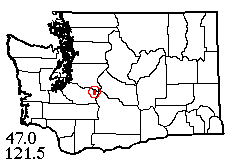 |
![]() 6 VIII 2010: Getting a good spider sample in August can be hard. The key to successful late summer collecting seems to be combining low and high elevation samples from one area. Today's plan was to collect at Dalles Campground along the White River highway (2160'), then at the 5280' summit of Sun Top, site of a fire lookout. Laurel and I enhanced our team with youthful Shannon Bowley, whom I've been helping to identify the spiders she rears and makes videos of. This was her first real collecting trip! As planned, the three of us combed the campground structures for spiders, getting 4 species including Novalena intermedia the "ranger station funnel weaver." I added two more from the understory. A big orbweaver that Shannon found proved to be native Araneus gemma. Across the river at the gate of McCullough Seed Orchard, we all swept grassy fields getting 6 more for a total of 13 mid-elevation species.
6 VIII 2010: Getting a good spider sample in August can be hard. The key to successful late summer collecting seems to be combining low and high elevation samples from one area. Today's plan was to collect at Dalles Campground along the White River highway (2160'), then at the 5280' summit of Sun Top, site of a fire lookout. Laurel and I enhanced our team with youthful Shannon Bowley, whom I've been helping to identify the spiders she rears and makes videos of. This was her first real collecting trip! As planned, the three of us combed the campground structures for spiders, getting 4 species including Novalena intermedia the "ranger station funnel weaver." I added two more from the understory. A big orbweaver that Shannon found proved to be native Araneus gemma. Across the river at the gate of McCullough Seed Orchard, we all swept grassy fields getting 6 more for a total of 13 mid-elevation species.
The lookout was staffed that day, letting us drive all the way up Sun Top; the summit area is an open parkland with small subalpine firs, the flowers now fading but still nice. Among us, we beat 11 species from fir foliage. Meadow foliage was much less productive with only 2 species identifiable. Shannon's young eyes spotted active Zelotes fratris and (prize catch of the trip) a day-active male of folding-door spider Antrodiaetus occultus, the first found north of Mt. Rainier. We spent our last couple of hours at a subalpine forest site south of the summit where we did even better: I sifted 7 species from fir litter, all of us collected from dead wood getting 9 species, and Laurel got 10 species from 166 white pine cones. The world's smallest mygalomorph (tarantula-like) spider Microhexura idahoana was here, also an undescribed Blabomma taken just once before, plus a microspider not yet placed even to genus. Even sweeping roadside verge and beating one especially lush fir tree added species. I was amazed by the day's total of 44 spider species. It sets a new record for August!
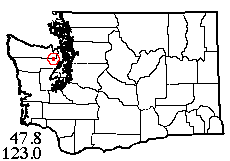 |
![]() 16 VIII 2010: I'd been to Mt. Townsend in 1998, when a very dry winter limited summer collecting in the high country, and got only 9 species. Laurel and I returned a month later in this much moister year and did much better, even though (due to a late start) we didn't have time to climb above treeline, but stopped in a subalpine meadow at the 4680-foot level (from 3360' at the trailhead). The meadow was exceptionally lush with scads of flowers in full bloom, butterflies flitting, and spiders available! Laurel swept 7 species here including yet another possibly new Pityohyphantes (this one lacks any pattern on the abdomen, most unusual!) while I got 6 from subalpine fir and 2 more from moss beside an adjacent stream. On the way up, Laurel had found nice big Araneus nordmanni and A. gemma in orb webs and 3 additional conifer spider species. Before heading back to the car, we stopped at the subalpine snack bar and had some of the most toothsome huckleberries I've ever tasted! Most of the flies here were rhagionids (those wimpy would-be biters), with just an occasional horse fly, and hardly any mosquitos.
16 VIII 2010: I'd been to Mt. Townsend in 1998, when a very dry winter limited summer collecting in the high country, and got only 9 species. Laurel and I returned a month later in this much moister year and did much better, even though (due to a late start) we didn't have time to climb above treeline, but stopped in a subalpine meadow at the 4680-foot level (from 3360' at the trailhead). The meadow was exceptionally lush with scads of flowers in full bloom, butterflies flitting, and spiders available! Laurel swept 7 species here including yet another possibly new Pityohyphantes (this one lacks any pattern on the abdomen, most unusual!) while I got 6 from subalpine fir and 2 more from moss beside an adjacent stream. On the way up, Laurel had found nice big Araneus nordmanni and A. gemma in orb webs and 3 additional conifer spider species. Before heading back to the car, we stopped at the subalpine snack bar and had some of the most toothsome huckleberries I've ever tasted! Most of the flies here were rhagionids (those wimpy would-be biters), with just an occasional horse fly, and hardly any mosquitos.
On the previous trip, we'd just climbed the mountain and hadn't gone downhill from the trailhead to Sink Lake, where Townsend Creek ceases (for a while) to be a surface stream. This time I wanted to go there because the old growth promised well for litter collecting. But I should have sifted subalipine litter instead – at the lower elevation (2980') lake, even in old growth western hemlock, I couldn't get any litter spiders. I did add 4 species to the list by tapping wood fragments, while Laurel swept the lakeside marsh, adding 2 more. Sink Lake was definitely worth visiting, spiders or not; the forest was magnificent and the silence was awe-inspiring! Not one sound of human origin could the ear detect. No birds vocalizing at dusk, almost no mosquitos even by the lake, and the flies had "gone to bed." Quietest place I've been to this decade. Daylight deserting us, we headed back to the ferry; along the (surprisingly, mostly paved) forest road we saw many moths, several bats, an owl and a deer, fitting conclusion to a fine day with 25 species collected (for 31 total with the 1998 records).
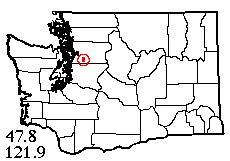 |
![]() 20 X 2010: This year I waited until fall spider fauna was in full swing. Laurel had other commitments until after our good-weather window, so I took the bus to Monroe, site of the Evergreen State Fair. It was a short walk to the almost deserted fairgrounds, with Evergreen Equestrian Park at the north end. Google Street View had shown me good conifer foliage habitat in the park's lawns. On the spot, the trees were a bit hard to identify, apparently a planted non-native spruce species. The 9 spider species in the foliage included numerous Zygiella atrica. This population has the carapace especially well marked (see album) with a "violin" (one of many spider species duplicating the allegedly "identifying mark" of the notorious "brown recluse"). Next, I found one gap in the blackberry-thicket barrier at the edge of the woods, leading to a deep stream ravine and some alder litter productive of 8 more species. That exhaused the developed part of the park – for the rest, it was mostly lawn still wet with the just-lifted fog. So I scrambled up a steep path to a hill crest from which trails (probably for horses) led in 3 directions. Some cottonwood-alder litter at the junction produced only a few species, but nice deep rich maple litter along 2 of the side trails jointly produced 16 spider and 3 harvestman species. One trail went down through a cut with rich fern foliage hanging down both sides, with 11 species of understory spiders. Farther down the trail was a wooded floodplain with moss (8 species sifted). I'd put off sweeping grass until the end, hoping the dew and fog-condensation would have dried in the afternoon sun. Much of it was still wet, and what had dried had plenty of blackberry lurking, but I managed to get 4 species of grass dwellers. I never actually saw a train, but they were passing all day with much hooting and wailing, reminding me of a Duke Ellington swing song. Finally I descended the hill through evening sun glare with 39 spider species, and didn't have long to wait for my return bus at the handy Park-and-Ride lot (hike-and-ride for me).
20 X 2010: This year I waited until fall spider fauna was in full swing. Laurel had other commitments until after our good-weather window, so I took the bus to Monroe, site of the Evergreen State Fair. It was a short walk to the almost deserted fairgrounds, with Evergreen Equestrian Park at the north end. Google Street View had shown me good conifer foliage habitat in the park's lawns. On the spot, the trees were a bit hard to identify, apparently a planted non-native spruce species. The 9 spider species in the foliage included numerous Zygiella atrica. This population has the carapace especially well marked (see album) with a "violin" (one of many spider species duplicating the allegedly "identifying mark" of the notorious "brown recluse"). Next, I found one gap in the blackberry-thicket barrier at the edge of the woods, leading to a deep stream ravine and some alder litter productive of 8 more species. That exhaused the developed part of the park – for the rest, it was mostly lawn still wet with the just-lifted fog. So I scrambled up a steep path to a hill crest from which trails (probably for horses) led in 3 directions. Some cottonwood-alder litter at the junction produced only a few species, but nice deep rich maple litter along 2 of the side trails jointly produced 16 spider and 3 harvestman species. One trail went down through a cut with rich fern foliage hanging down both sides, with 11 species of understory spiders. Farther down the trail was a wooded floodplain with moss (8 species sifted). I'd put off sweeping grass until the end, hoping the dew and fog-condensation would have dried in the afternoon sun. Much of it was still wet, and what had dried had plenty of blackberry lurking, but I managed to get 4 species of grass dwellers. I never actually saw a train, but they were passing all day with much hooting and wailing, reminding me of a Duke Ellington swing song. Finally I descended the hill through evening sun glare with 39 spider species, and didn't have long to wait for my return bus at the handy Park-and-Ride lot (hike-and-ride for me).
 |
![]() 3 XI 2010: A rainy period finally yielded to 2 sunny days with record high temperatures. On the second, Laurel and I headed east of Snoqualmie Pass to the old mining town of Roslyn, where the Coal Mines Trail follows an old rail route. After checking out a different, less-promising trail north of town, we strolled down the rail route and immediately found sweepable fields. The grass produced only a few spiders at first, then one specially rich section added several species for a total of 10. Meanwhile, Laurel found her favorite habitat, Ponderosa pine cones, fallen but not very well opened. Besides numerous juvenile lycosids and gnaphosids, she did get 7 identifiable species, featuring Agroeca ornata. A short side road brought me to riparian cottonwoods and several bags of cold, unproductive leaf litter before I got some good spiders in litter on a sunny slope – 12 species including 3 not yet identified! I also (unluckily) grabbed a small bagfull of cold litter from a ravine bottom for the Berlese funnel. Both Laurel and I found some Douglas-firs in the understory to beat (10 species), and had exceptionally good luck sweeping bracken, snowberry and herbs in the understory, for 10 more species including several specimens of an unidentified erigonine microspider. A discarded suitcase Laurel found added 3 species from its interior! With the sun sinking, I sifted 5 species from a different kind of litter (probably Douglas maple), and turned over a few more rocks. Just the few rocks I was able to find gave me 4 good spider species. Total, 47. On the way hone, we were glad to find our beloved Moutain High Burgers in Easton open for business.
3 XI 2010: A rainy period finally yielded to 2 sunny days with record high temperatures. On the second, Laurel and I headed east of Snoqualmie Pass to the old mining town of Roslyn, where the Coal Mines Trail follows an old rail route. After checking out a different, less-promising trail north of town, we strolled down the rail route and immediately found sweepable fields. The grass produced only a few spiders at first, then one specially rich section added several species for a total of 10. Meanwhile, Laurel found her favorite habitat, Ponderosa pine cones, fallen but not very well opened. Besides numerous juvenile lycosids and gnaphosids, she did get 7 identifiable species, featuring Agroeca ornata. A short side road brought me to riparian cottonwoods and several bags of cold, unproductive leaf litter before I got some good spiders in litter on a sunny slope – 12 species including 3 not yet identified! I also (unluckily) grabbed a small bagfull of cold litter from a ravine bottom for the Berlese funnel. Both Laurel and I found some Douglas-firs in the understory to beat (10 species), and had exceptionally good luck sweeping bracken, snowberry and herbs in the understory, for 10 more species including several specimens of an unidentified erigonine microspider. A discarded suitcase Laurel found added 3 species from its interior! With the sun sinking, I sifted 5 species from a different kind of litter (probably Douglas maple), and turned over a few more rocks. Just the few rocks I was able to find gave me 4 good spider species. Total, 47. On the way hone, we were glad to find our beloved Moutain High Burgers in Easton open for business.
Now for the unlucky part. I loaded the litter into my old reliable Berlese funnel in my office. First time I've used it this year. Next day, the Executive Director happened upon it – uh-oh! In technical violation of a policy against sources of live bugs in the museum, it put me in serious hot water and the funnel (really not a source of collection pests) out-of-bounds for the future. However, she's the boss!
And alas, the rest of the fall mostly failed to produce any collecting weather. I was all set to do a bus trip on the most propitious day, but failed to get enough sleep, so had to call it off. However...
Stay tuned for more collecting in the spring!
This page last updated 21 March, 2025